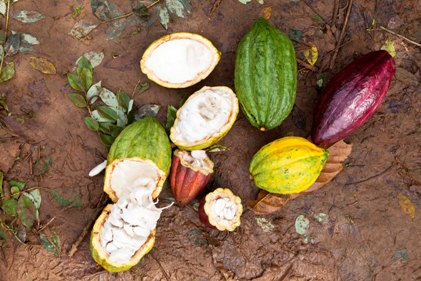
|
| Photo of cocoa pods provided Mars. |
The thing about the 2020 sustainability goal is that everyone already knows there’s no way every single company will be able to get 100 percent “Fairtrade” chocolate.
Of course, there’s a big difference between “sustainable” cocoa and “Fairtrade” cocoa.

|
| Crystal Lindell |
Heck, Fairtrade itself had to split into Fairtrade International and Fairtrade USA (they can’t even agree amongst themselves!) so now there’s even a distinction between “Fairtrade Internationally certified products” and “Fairtrade USA certified products.” It's not much, but it's there.
And even if every major chocolate company did want to use Fairtrade International to certify their cocoa supply by 2020, they probably wouldn’t be able to.
The organization probably wouldn’t have the capacity to certify all the cocoa it would take to supply every company that has a 2020 goal.
For those of you who have been living under a candy-coated rock for the last few years, let’s take a couple steps backwards.
Basically all the major chocolate companies — Hershey, Mars, Nestlé, Mondelez and Ferrero — have pledged to source all of their cocoa from certified sources by 2020.
First and foremost, this is about child labor.
Yes, there is a difference between children working on a family cocoa farm and kids in a sweatshop, but even if they’re just helping out on the family farm, they still need to be going to school and getting an education. And so, chocolate companies want to make sure the cocoa farmers’ kids are going to class before they help bring in the crop.
Beyond that though, the chocolate companies also want to make sure that cocoa farmers are earning a decent wage for the cocoa they’re growing.
As Harriet Lamb, CEO of Fairtrade International puts it, “In the ultimate irony, half of the world’s hungriest people are the smallholder farmers, yet they grow 70 percent of the world’s food.”
Basically, the people growing the world’s food aren’t eating it, and that’s just wrong no matter how you look at it.
The sustainability seal also makes sure farmers aren’t cutting down rainforests so they can plant more cocoa trees.
So, at the end of the day, it’s pretty basic. 1. Stop child labor. 2. Pay decent wages to cocoa farmers. 3. Save the planet.
And so, many companies rightly believe they don’t need one specific certification company to tell them if they’re accomplishing those things.
Thus, although all the major chocolate companies are planning to source 100 percent sustainable cocoa by 2020, the definition of the word “sustainable” is probably going to evolve over the next seven years.
At least that’s how Kip Walk, corporate director, sustainability for The Blommer Chocolate Co., sees it.
Walk recently discussed certification and the 2020 goal during our webinar (if you haven’t already watched it, you should do that now, here. It’s free and it’s incredibly interesting).
He says that there’s going to be a “evolution” of sustainable definitions, although he’s quick to point out that “evolution” doesn’t mean “watered down”.
Instead, it will probably mean more companies doing individual programs, or turning to different groups. He pointed to the Nestle Cocoa Plan and Starbucks Cocoa practices as examples.
As for companies that do use third-parties, it will get harder and harder for them to rely on just one certification organization to certify their cocoa.
For example, Hershey already has said that it’s sourcing cocoa through multiple organizations, including UTZ, Fairtrade USA and Rainforest Alliance to meet its 2020 goal. And, the company has said that as its buying volume increases, it plans to work with even more certification organizations.
Words like “sustainability” and “certification” are easy to brush aside and ignore. And, depending on which sector of the candy industry you’re in, it can be easy to pretend like these things don’t affect you.
But consumers have a hard time ignoring the words “child labor” and “chocolate.”
And so, as the certification process continues, and 2020 edges closer and closer, this will undoubtedly affect everyone from the cocoa farmer in the Ivory Coast to the candy shop owner who stocks chocolate bars near the register.
The good news is everyone is at least aware of the fact that there needs to be some pretty big improvements in the cocoa supply chain. Everyone knows that there’s a lot that can be done to make things better, and admitting you have a problem is half the battle.
As Walk says, “I do believe we will reach our goals in 2020, as daunting as some of the challenges may be. but I do not believe that in 2020 we’ll be looking at sustainability in the same light that we do today.”
In other words, it is possible for all the major chocolate companies to source their cocoa sustainably in the next six and half years. It’s going to be hard, it might not look exactly how we think it should, but it can be done.

